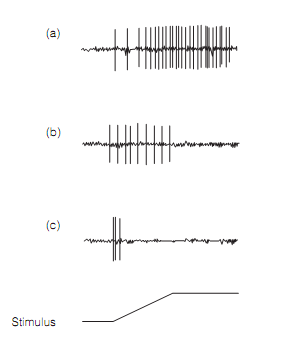Static and dynamic rate coding
The Stimulus intensity is encoded by the mean rate at which the sensory neuron fires. Afferents fall among the two end-members depending on the nature of their sensory receptor.
A slowly adapting receptor reacts to a protracted stimulus for as long as the stimulus lasts, causing its sensory neuron to fire repeatedly with a frequency which associates to the magnitude of the stimulus. These neurons display static (i.e., tonic) responses to a constant stimulus. In contrast, fast adapting receptors respond only temporarily to a constant stimulus as they soon become the insensitive, or adapt, to it. These receptors react best to changes in stimulus intensity. Their afferents illustrate dynamic (phasic) responses. Most of the afferents exhibit a mixture of dynamic and static responses. The illustrations of static and dynamic responses are shown in figure below, which compares the three classes of afferent in the skin which are wired to various kinds of mechanoreceptor.

Figure: Static and dynamic afferent neuron responses to the skin displacement: (a) static response of Ruffini organ afferent; (b) the dynamic response of Meissner’s corpuscle afferent to velocity of displacement; (c) the dynamic response of Pacinian corpuscle afferent to the acceleration.
The starting and end of a stimulus will be signaled by modifications in the rates of firing of slowly adapting afferents, and by the transient bursts of firing from quickly adapting afferents. In this manner the stimulus period is encoded.